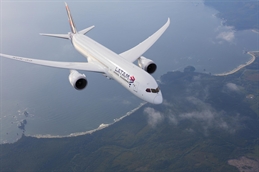
LATAM Cargo started the new year with a new catalyst for growing its perishables business. On January 16 Latin America’s largest carrier opened a US$3.5 million perishable hub facility at Sao Paulo’s Guarulhos airport (GRU), the carrier’s largest hub.
The 1,637 sq m facility has increased LATAM’s perishables handling capacity at GRU by 33%. According to the airline, it reduces the exposure of perishable shipments to non-controlled temperature conditions by more than 20%.
Andres Bianchi, CEO of LATAM Cargo, remarked that the facility allows the airline to handle perishables differently – both in terms of transit times and the breakdown and build-up to match different aircraft types.
GRU has grown in importance for the airline since the merger of LAN and TAM.
Previously the former had focused its cargo business predominantly on its freighter operations, but the emphasis subsequently shifted more towards cargo planes feeding the belly network, in which GRU is the biggest hub. It has connections to 33 destinations in South America and 14 cities in North America, Europe, Africa and Asia.
Bianchi remarked that the new perishables hub is geared towards transit cargo. Some 85% of the airline’s connecting cargo at GRU is perishables. About 19% of LATAM’s salmon traffic is routed over GRU, mostly headed to the US and China.
Dallas Fort Worth International Airport (DFW) has positioned itself as a transit point for air cargo flows between Latin America and Asia. A key plank in this strategy was the establishment of a 14,000 sq ft cooler facility, part of a 37,000 sq ft cargo center, which opened in late 2017.
Shawn McWhorter, president for the Americas region of Nippon Cargo Airlines, commented that the development of the air cargo complex has made a considerable difference for cargo transfers. He has been talking with Avianca about interlining traffic at DFW. The Colombian airline started a twice-weekly freighter service between Bogota and DFW in October with Airbus A330-200F aircraft.
The operation marked the first scheduled all-cargo route to Latin America for DFW and was hailed by the airport authority as a major milestone in its strategy. “We think this is a validation of what we’ve been working towards,” said John Ackerman, executive vice-president, global strategy and development at DFW. “It’s difficult to be taken seriously as a gateway between Asia and Latin America if you don’t have a freighter connection.”
According to Ackerman, routing perishables from Latin America to Asia over DFW can shave as many as three to five days off the transit time, compared to flying them to Miami, the premier US gateway for Latin American traffic, and trucking them to connecting flights to Asia from gateways like Chicago or Los Angeles.
Ted Stevens Anchorage airport in Alaska also has transfer ambitions. UPS and FedEx shift cargo between their various trans-Pacific flights at the airport, but most other freighters coming through only stop for fuel. The airport authority is planning to build a new cargo warehouse and freighter parking stands. Located closer to the ramp, this will eliminate a lengthy trek to the existing cargo terminal, which has been one impediment to transfer plans.
Another scheme is the planned installation of crab refreshing tanks. Flying them to Anchorage from coastal Alaskan waters and resting them there for two or three days makes it possible to ship live king crab to Asia, said airport director Jim Szczesniak.
Vancouver airport also beefed up its transfer capabilities last year in the wake of the expansion of its international passenger terminal. This created some covered space for transit cargo.
“Now we won’t have to move it to the cargo terminal,” said Jason Tse, manager, commercial leasing – cargo, at the airport authority.
Air Canada is the main user of this facility. About 70% of its traffic at Vancouver is transit cargo.
At the Asian end, hubs like Singapore Changi and Hong Kong have traditionally had significant portions of transit cargo. Recently transhipment activity at Hong Kong International Airport has been weak, though, the airport authority reported.
Hong Kong International Air Cargo Terminals (HACTL), the largest handler at the airport, has improved the loading process on the ramp with a new airside management app that is fully integrated with HACTL’s community system. The new eLoading Instruction is automatically synchronized between load control and the ramp team’s mobile devices, so ramp staff always have the latest updates on shipments in their devices. This speeds up processes and eliminates errors.
Transit ULDs that do not touch the HACTL terminal are aligned with the other dolly chains at the aircraft side. “Their position is also recorded in the mobile app and they can then be towed separately for loading at the appropriate time and in the appropriate sequence,” a spokesperson for HACTL reported.
ULD providers and airlines have begun to equip their containers and pallets with Bluetooth tags for tracking. This promises further efficiencies, but not just yet.
“In theory, it will be easier and quicker for a handler like HACTL to track a transit ULD’s location. In practice, we are not yet being sent the corresponding checking authority to enable us to track and update the location of transhipped units. The various stakeholders need to consider how to share this checking authority with the appropriate parties, which may include various airport operators, airlines and multiple ground handlers around the world,” the spokesperson said.
By Ian Putzger
Air Freight Correspondent | Toronto



